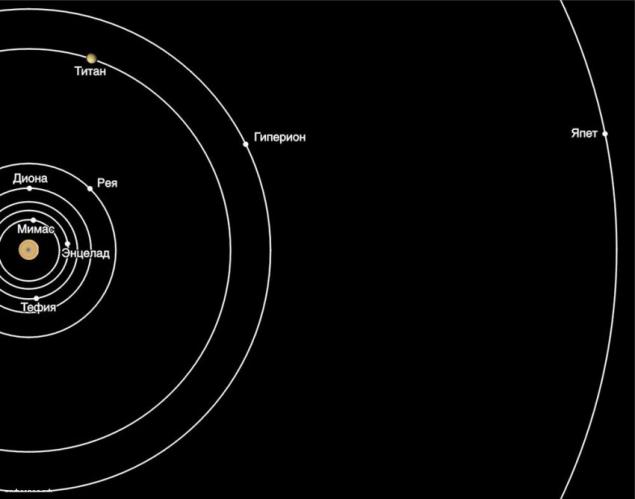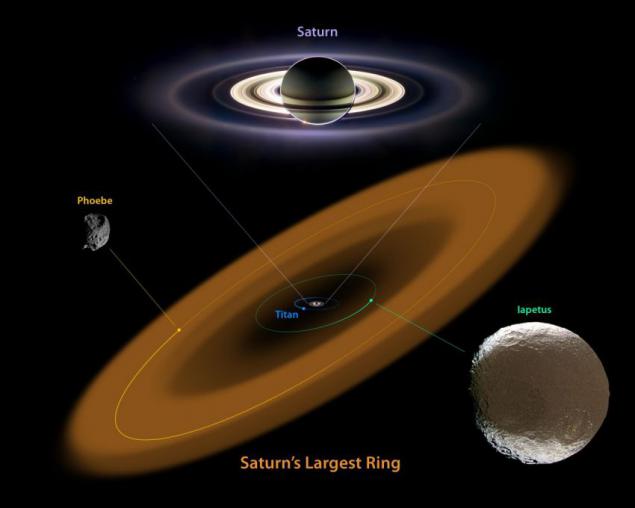Iapetus, the son of Uranus and Gaia
 Bashny.Net
Bashny.Net

Iapetus is one of the four satellites, discovered in 1672 by Giovanni Cassini. But icy moon has long disappeared from the Italian astronomer. He saw his first western side, but when he tried to observe its eastern side 39 days later, no trace of the satellite he found. The situation is repeated throughout the 79-day trip to the satellite orbit, Cassini has suggested that the satellite is rotated to the planet all the time on one side and one side is darker than the other.
Cassini named the four moons he discovered (Iapetus, Rhea, Dione and Tethys) stars of Louis, in honor of King Louis XIV. For many years, the satellites have a numerical designation, depending on their location to Saturn. First Iapetus was called Saturn V, but after the opening of Mimas, Enceladus and Hyperion was called Saturn VIII. Almost 200 years later, John Herschel suggested satellites around Saturn called in honor of the Titans - brothers and sisters of the Greek god Cronus, who was known to the Romans as Saturn.
In Greek mythology, Iapetus, is the son of Uranus and Gaia and the father of Prometheus and Atlas. Prometheus - the Titan who fret fire people and allowed the ancient Greeks believed Iapetus as the father of the human race.
Main attractions on Iapetus have names of the French epic poem "The Song of Roland."

Contrasting side of the satellite separated sufficiently clear boundaries, only one place she gets a little blurred outlines, advancing on the white part of Iapetus. The main color of Iapetus can be considered still white, as the satellite is likely nothing more than as a super-giant space rocks of water ice. Anyway, its density is defined the same as that of the ice. As for the black substance, there is an impression that the surface they just sprinkled ...
Style rotation of the satellite around Saturn Iapetus is the same as that of the moon - they both turned to their planets only one side. In addition, moving in its orbit, Iapetus dark side flies forward as if something is strewed him straight in the "face».
Perhaps the secret dark color already solved. Scientists at Cornell University suggested that the surface of Iapetus sprinkles dust another Saturnian moon - Phoebe. He constantly comes into collision with other space bodies and drags black dust tail. Phoebe flies towards the satellite Iapetus and so he gathers all the dust, which Phoebe leaves in space.
Heat Cassini observations provide a better understanding of the unique process. Slowly rotate the satellite means that the dark surface that absorbs more heat than their icy part, there is more time to warm up. Any icy material, mixing with a dark surface, the transition into a gaseous form, returning to the cooler regions of the satellite. Thus, the dark side keeps getting darker, while the light is getting brighter. The temperature on the warm side of the dark reaches minus 143 degrees Celsius (minus 226 F). The bright side, which absorbs less heat is cooler with temperatures averaging minus 173 C (minus 280 F).
As well as all the celestial bodies, with little or devoid of atmosphere, Iapetus was badly damaged by cosmic meteor attacks. Craters on its surface a lot, some very broad, while others go to the unfathomable depth. One of them has steep walls to a height of fifteen kilometers.

After the space probe Cassini began to transmit the information found another mysterious detail of the relief of the satellite Iapetus. Directly on the equator, belting it located ridge with a height of not less than thirteen miles and a width of approximately about twenty. Where did he come from - is unclear, but perhaps this mountain range was formed because of tectonic shifts in the times of formation of Iapetus. There is also a version for which to blame too rapid rotation and, as a consequence, strong heating of the satellite.
Today, however, there is another version. Using 3D map consisting of data Cassini researchers believe that they have the most probable hypothesis of its origin.
As a rule, the mountains on Earth are formed as a result of side effects of plate tectonics and volcanic activity. Alas, on Iapetus is not anything like that. Furthermore, mountain having 6 miles in height is too steep, so that their origin could be explained by conventional mountain-building mechanisms. So how does this ridge formed?
Researchers believe that the material of which the mountains are composed, is "exogenous" origin. In other words, it came from outer space. In a paper presented at arXive, researchers point to a possible collision of Iapetus and other planetary bodies, creates a huge amount of garbage. This debris flew into orbit around the equator of Iapetus and, ultimately, in the form of rain fell on his face and formed the equatorial mountains.
Another theory suggests that Iapetus could have had its own moon, which collapsed under gravity, creating a ring system, and collapsed on the surface of Iapetus.
But Whatever the theory, all scholars agree that Iapetus could not create a mountain range without help from outside.

Compared to other "vassals" of Saturn moon Iapetus has a sufficiently rapid rotation, but it was frozen for a long time. In our solar system is not so much the objects that with certainty could demonstrate its early history. Iapetus today - it's something like a "cryo-chamber" in which intact stored all the information about the early period of its existence.
Under the crust of ice very well looked relict sediments. They keep perfectly still for at least a few hundred million years. But the bulk of the satellite Iapetus was formed at a time when there were only the beginnings naZemle atmosphere, Mars could boast the presence of water, and all the other planets in our solar system is only starting to develop.
According to Dennis Metsona, astronomer from NASA, Iapetus is much slower today makes a complete revolution around Saturn - it needs to almost eighty days. Three billion years from now deep into ancient times, the satellite is just enough for five hours.
Mysterious and strange Iapetus attracts the attention of many scientists, and while it will not be solved riddles interest to the satellite Iapetus hardly weaken.

Tags
See also
Mucha, Ivan, Albert II and 10 more animals, have been in space
The truth about the mysterious center of our Universe
The space of the home, part 4: how will we live on Venus
West choice of Russian power
Alex Kurilko: "it pains Me to remember many things, but I'm not sorry»
Interesting facts about dolphins
News in pictures
From the world of music
What I do not like to talk
















